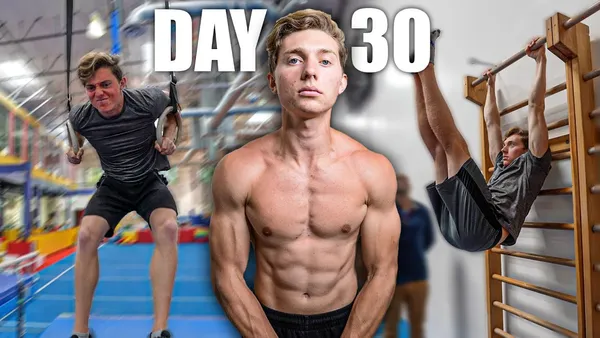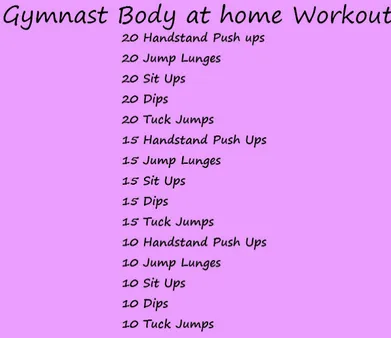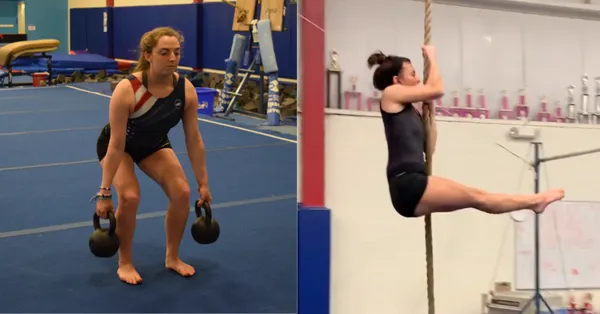Table of Contents
Gymnasts are renowned for their incredible strength and agility. Their gravity-defying moves and seemingly effortless grace speak to years of dedicated training and unwavering focus. There's no one method, tips, tricks that apply to everyone. But, with the right guidance, you can craft a workout routine that helps you replicate their impressive feats. Welcome to Kizworld, where we walk you through the journey on How to train like a gymnast and attain your gymnastic goals. Keep reading to discover the secrets of these athletic marvels!
How to Train Like a Gymnast: A Comprehensive Guide to Achieving Gymnastic Excellence
I. How Much Do Gymnasts Work Out Daily?
How Much Do Gymnasts Work Out Daily?
Gymnasts' Daily Workout Schedule
- Morning Session: 9:00 AM - 12:00 PM
- Lunch Break: 12:00 PM - 1:00 PM
- Afternoon Session: 1:00 PM - 4:00 PM
- Evening Session: 6:00 PM - 9:00 PM
Gymnasts typically train for 20-30 hours per week, with two to three sessions per day. Their workouts include a variety of activities, such as:
- Strength training: This helps gymnasts build muscle and power, which they need for performing their skills.
- Flexibility training: This helps gymnasts improve their range of motion, which is essential for many of their skills.
- Skill training: This is where gymnasts practice their routines and work on new skills.
- Cardio training: This helps gymnasts improve their endurance and cardiovascular health.
Gymnasts also spend a lot of time working on their mental skills, such as focus, concentration, and confidence. They also need to be able to handle the pressure of competition.
The amount of time that gymnasts spend training varies depending on their age, skill level, and goals. However, all gymnasts need to put in a lot of hard work and dedication in order to succeed.
Learn more about the benefits of gymnastics for kids
Tips for Training Like a Gymnast
- Start slowly and gradually increase your training intensity and duration.
- Focus on proper technique to avoid injury.
- Listen to your body and take breaks when you need them.
- Stay hydrated and eat a healthy diet.
- Get enough sleep.
- Find a qualified coach who can help you develop a training program that is right for you.
With hard work and dedication, you can achieve your gymnastics goals.
Read our guide on how to improve your flexibility and mobility with gymnastics
II. What is the Gymnast’s Workout Routine?
What is the Gymnast’s Workout Routine?
Gymnastics Beginners – Flexibility and Fundamentals
For gymnastics beginners, the focus is on building a solid foundation of flexibility, strength, and coordination. Gymnastics for beginners typically incorporates exercises aimed at developing core strength, upper body strength, and lower body power. Some commonly practiced exercises include:
- Stretching and Flexibility Drills: Various stretching and flexibility exercises are crucial to enhance range of motion and prevent injuries.
- Bodyweight Exercises: Bodyweight exercises lay the groundwork for building strength without requiring gym equipment. Examples include squats, push-ups, lunges, and planks.
- Coordination and Balance Exercises: Coordination and balance drills are essential for gymnasts to control their movements and maintain proper form. These exercises often involve hopping, skipping, and balancing on one leg.
At this stage, it's important for beginners to master the basics, focusing on proper form and technique rather than attempting advanced skills.
Gymnastics Intermediates – Building Strength
As gymnasts progress to the intermediate level, they begin to incorporate more challenging exercises that target specific muscle groups and develop strength. Some exercises that are often included in intermediate gymnastics routines are:
- Weightlifting: Weightlifting exercises such as deadlifts, bench press, and squats help build muscular strength, particularly in the upper body, legs, and core.
- Gymnastics Rings: Gymnasts use rings to develop upper body strength, grip strength, and coordination. Ring exercises include muscle-ups, dips, and inverted rows.
- Vaulting Exercises: Intermediate gymnasts start practicing vaulting, which involves running and propelling themselves over an apparatus known as the vaulting horse.
At this level, gymnasts start working on more advanced skills on various gymnastics equipment, such as the uneven bars and balance beam.
Gymnastics Advanced – Practical Drills
Advanced gymnasts engage in highly specialized training, performing complex skills and routines that require exceptional strength, flexibility, and coordination. Their workouts involve:
- Specific Apparatus Training: Advanced gymnasts dedicate significant time to practicing on specific gymnastics apparatus, such as the uneven bars, balance beam, and parallel bars. They work on refining their techniques and executing intricate skills.
- Plyometric Exercises: Plyometric exercises involve explosive movements that help gymnasts generate power and speed. Drills include box jumps, tuck jumps, and depth jumps.
- Advanced Strength and Conditioning: Advanced gymnasts engage in intensive strength and conditioning programs to maintain peak physical performance. These programs include exercises that target specific muscle groups and improve overall athleticism.
At this level, gymnasts train rigorously to perfect their skills and prepare for competitions.
Regardless of their skill level, gymnasts should always prioritize proper warm-up and cool-down exercises to prevent injuries and optimize performance.
To learn more about the specifics of a gymnast's workout routine, refer to our article on How to Train Like a Gymnast.
III. Gymnastics Skill Progressions
Gymnastics Skill Progressions
Gymnastics skills can be categorized into six main apparatus groups: floor, vault, parallel bars, rings, uneven bars, and high bar. Proficiency in each apparatus group builds upon basic movements mastered at beginner and intermediate levels. Below is an in-depth look at representative skills for each level and apparatus group.
Apparatus | Beginner (Ages 6-8) | Intermediate (Ages 9-12) | Advanced (Ages 13+) |
Floor | • Forward and backward rolls • Cartwheels • Handstands against the wall | • Back handsprings • Round-offs • Forward and backward walkovers | • Full twists • Double backflips • Triple saltos |
Vault | • Straddle vault • Squat vault • Handspring vault | • Tsukahara vault • Yurchenko vault • Double front vault | • Kasamatsu vault • Produnova vault • Amanar vault |
Parallel Bars | • Kips • Swings • Pull-ups | • Skin the cat • Circle swings • Handstand push-ups | • Straight bar dismount • Double leg circles • Piked Jaeger |
Rings | • Support • Hanging • Knee raises | • Pull-ups • Dips • Single leg circles | • Iron cross • Muscle-ups • Double straight planche |
Uneven Bars | • Hanging • Knee raises • Kip casts | • Pull-ups • Swings • Handstands | • Giant swings • Back handsprings • Double somersaults |
High Bar | • Pull-ups • Swings • Knee raises | • Casts • Handstands • Shoulder circles | • Front somersault dismounts • Double front saltos • Tkachev releases |
Gymnasts progress to advanced drills and skill progressions only after achieving proficiency at lower levels. Mastery of fundamental techniques is essential for the safety and success of gymnasts as they strive to master increasingly complex skills.
Here are some helpful links for learning more about gymnastics skill progressions and training:
- The Best Gymnastics Drills and Exercises
- The Top Gymnastics Competitions and Events
- How to Choose the Right Gymnastics Leotard
- The Difference Between Artistic, Rhythmic, and Acrobatic Gymnastics
- The Best Gymnastics Books and Podcasts
IV. Guidelines for Training Like a Gymnast
Guidelines for Training Like a Gymnast
Balancing a Gymnast’s Workout
When working out like a gymnast, maintaining a balanced routine is paramount. Just like in training a martial artist, achieving optimal results requires a comprehensive regimen encompassing strength training, cardiovascular fitness, and flexibility. Gymnasts incorporate a melange of exercises to achieve these goals, including...
- High-intensity interval training (HIIT)
- Yoga
- Cross training
- Bodyweight exercises
- Weightlifting
...
Day | Focus | Exercises |
Monday | Strength Training | Squats, bench press, pull-ups, rows |
Tuesday | Cardio | Running, swimming, cycling |
Wednesday | Flexibility | Yoga, stretching |
Thursday | Cross Training | Rock climbing, dancing, martial arts |
Friday | Bodyweight Exercises | Push-ups, sit-ups, leg raises |
Saturday | Weightlifting | Deadlifts, overhead press, bicep curls |
Sunday | Active Recovery | Light yoga, walking |
...
The above routine serves as a general template; the specific exercises and duration should be individualized to one's fitness level and goals. Constructing a well-rounded workout schedule will elevate your physical prowess and minimize the risk of injury.
Gymnastics Diet for Enhanced Power
A nutritious diet is the cornerstone of a gymnast’s training regimen. Gymnasts typically consume diets rich in the following nutrients...
- Complex carbohydrates
- Lean protein
- Healthy fats
- Vitamins
- Minerals
...
Let's delve into the foods that gymnasts often incorporate into their meals:
- Carbohydrates: Oats, brown rice, potatoes, whole wheat bread, fruits
- Proteins: Chicken, fish, beans, lentils, tofu, eggs, Greek yogurt
- Fats: Nuts, seeds, avocados, olive oil, fatty fish
- Vitamins and Minerals: Leafy greens, bell peppers, berries, citrus fruits
...
Additionally, sufficient hydration is crucial for gymnasts. Maintenance of proper fluid levels is integral for optimal performance and recovery.
Achieving Gymnast-Level Flexibility
Gymnasts possess enviable flexibility, a product of dedicated stretching and mobility exercises. Incorporating these exercises into your routine can enhance your range of motion, reducing the risk of injury and improving performance. Here are some exercises gymnasts do to heighten their flexibility:
- Splits: Practicing the splits develops flexibility in the legs and lower back.
- Bridge: The bridge pose stretches the spine, shoulders, and hamstrings, enhancing flexibility.
- Pike: This stretch targets the hamstrings and lower back, improving flexibility.
- Quad stretch: Stretching the quadriceps muscles prevents tightness and injury.
- Calf stretch: This stretch improves flexibility in the calf muscles, reducing the risk of strains.
...
"Flexibility is a gymnast’s superpower, enabling grace and agility. Nurturing flexibility with persistence and dedication unlocks this potential."